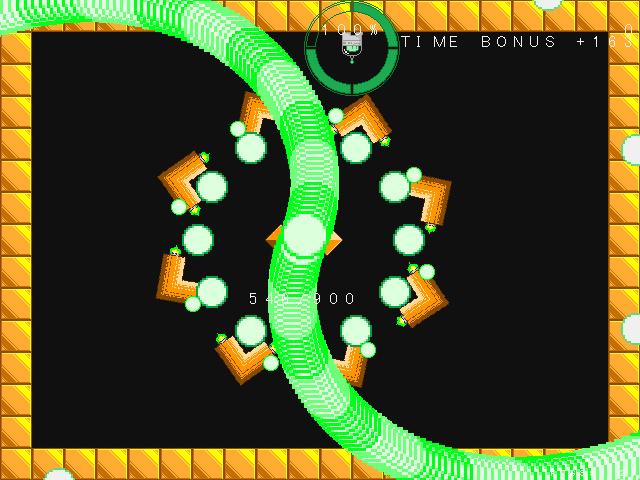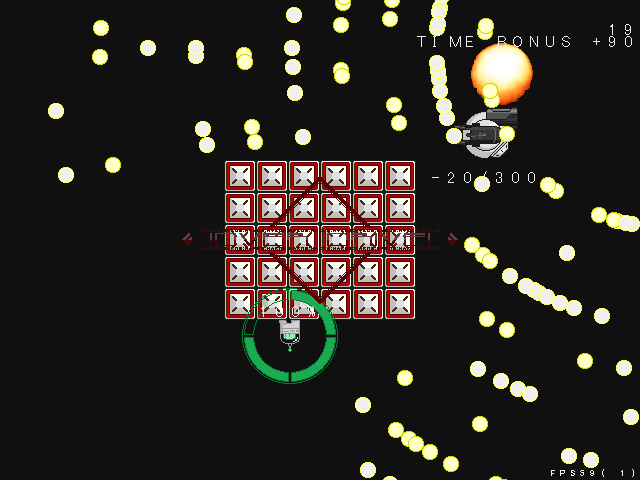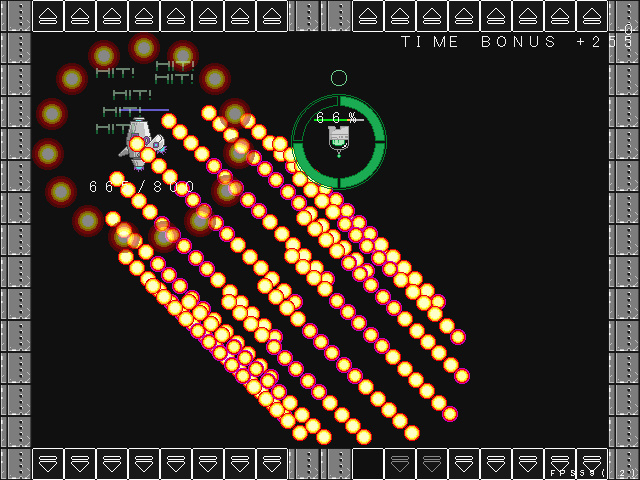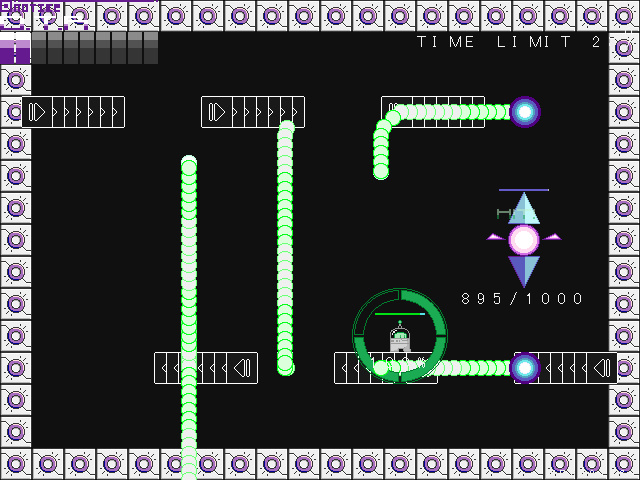Eden Reverse is a short cross between a platformer and a shmup without feeling entirely like either. Your character can stay in the air for quite a while before falling back down to the ground, but the main feature is hinted at by the title itself. Specifically, you can reverse gravity to walk on the ceiling. This is far from the only game to feature such a mechanic, but Eden Reverse is rather unique among these types of games in its pure focus on boss fights. With gravity controls, a jetpack that lets you remain in the air for extended periods of time, and creative boss fights within often equally creative arenas, this little game packs a big punch.
You can move fairly quickly and you have plenty of mobility beyond your run speed. First, there’s your jump. This jump is entirely dependent upon how long you hold down the button; simply tapping the jump button will do virtually nothing. It’s really more of a jetpack mechanic as it causes a column of bullets to propel your character upward from below. Your vertical speed isn’t as high as your standard run speed so you need to use some precision while flying through the air. On top of this, your jetpack has a limited amount of fuel so you can’t stay in the air forever, though your fuel will immediately refill upon touching the ground and you can extend the amount of time you stay in the air by letting go of the button every now and then. In general, this jump feels like it embodies the game’s hybrid nature as it lets you freely fly through the air like in a shmup, but you do still need to land on the ground once in a while and also take gravity into account.
The reverse mechanic is where you get a truly massive boost to your mobility. You can reverse gravity at any time in the air or on the ground to walk along the ceiling or to set it gravity back to normal. The one exception is you must touch a solid surface before you can reverse gravity again so you can’t use it to stay in the air indefinitely. The key part here is that this ability can be combined with your standard hovering jump. If you reverse gravity and then realize that the surface you’re heading towards is dangerous, you are still free to make use of your flight to slow your ascent (or descent) until the landing area becomes safer. Likewise, you can initially make use of your jump to attack a boss when it’s in the air near you and then make use of the reverse ability to get far away when the boss starts to launch a big attack.

Your own attack rapidly shoots large bullets in a straight line in front of you as well as two weaker, diagonal lines of bullets above the main one and another two below. With this weapon, the game encourages you to get very close to bosses to hit with all your bullets at once, making your aerial mobility skills particularly crucial. However, this design also means that it’s easy to deal at least a little chip damage to bosses regardless of your relative orientation. In other words, the developer of this game has done a great job in terms of creating a weapon which fully takes the other mechanics into account for both offensive and defensive purposes. Eden Reverse is far from the first game to incorporate gravity reversal and this particular type of gravity reversal was even popularized long ago by VVVVVV, yet it’s the only game I know of which gives you simultaneous access to such a power and a generous jetpack-like jump to allow for an incredibly satisfying amount of mobility.
This is a game which consists entirely of boss fights, so let’s take a look at them. Each fight takes place within a single screen and just about every boss has a few hundred more health than the boss which came before it. In terms of design, these bosses definitely belong to the realm of shmups. these are fairly large, mechanical foes which fly all over their arenas, completely unbound by gravity. Bosses have plenty of attacks consisting of bullet barrages, though these attacks are often designed to take your specific abilities into account. For example, the very first boss periodically rushes along the walls, forcing you to make use of both your jump and your reverse to time your dodges, especially if you want to get in some damage along the way. Yet another boss temporarily destroys large parts of the floor and ceiling with its attacks while also forcing you to reverse gravity in order to get out of the way of its rotating bullet barrages; you have to keep on the move while using your jetpack to delay your landing just enough to avoid falling straight into a pit.

Boss fights are rarely over just because the boss has run out of health. For most fights, getting a boss down to zero health will stop the timer, which is used alongside your remaining health (you start each fight with four) for calculating your score. However, once a boss runs out of health it will enter a desperation mode while it’s exploding. This mode generally consists of the boss using a far more aggressive variation on one of its original attacks and it’s purely a matter of survival. You can still shoot the boss to shove its health deeper into the negatives, but I haven’t noticed any benefit to doing so. On top of this, each boss will speed up this already rather dangerous attack after a few seconds and only after withstanding this very last assault will the boss finally explode. Even though a few of the later bosses don’t have a desperation mode, these bosses have gimmicks of their own to make up for it, such as entering an entirely new phase when they reach a certain amount of health or requiring you to defeat them within a time limit.
The arenas play a huge rule in shaping the boss fights and giving Eden Reverse a stronger sense of identity. The most interesting arena in the game is probably the second one. In this boss fight, the only solid ground is a giant square in the center of the screen. The boss has attacks which will hit two or three sides of the square simultaneously, so you must frequently alternate between the top and the bottom of the square and sometimes even possibly hover against one of the sides for a while. Since there is nothing but the void on the top and bottom of this arena, switching directions involves jumping off the edge of the square and falling until you pass the other side to loop around. Reversing too late will result in you falling into the void while reversing too early means you’ll need to rely on your jetpack to hopefully save yourself. The other arenas are still often interesting in their own ways, such as with moving platforms or the previously-mentioned destructible floors, which disappear shortly after you touch them on top of the boss’s own attacks breaking them. Even the seemingly standard empty, rectangular arenas take their bosses into account as the inhabitants of these arenas have attacks which require you to run in circles between the floor and ceiling.

Aesthetically, Eden Reverse is a bit of a mixed bag, though a mostly positive one. The soundtrack is solid with plenty of energetic songs and every boss has its own theme. The graphics department is where this game takes a hit. The art is about average for freeware standards, neither incredible nor particularly painful to look at and the boss designs are mostly interesting. However, there is a distinct lack of animation. Some of the bosses have decent animation, but others simply glide or teleport around the screen with little to nothing in the way of animation. Your own character is the most infamous of all in this regard; there’s a neat death animation where you phase out of existence, but the protagonist otherwise has no animation whatsoever, even going so far as to glide along the ground despite clearly having feet.
Shortcomings in terms of animation are made up for by the handy UI elements. Your own health is represented by a giant ring divided into four segments around your character so you never need to glance away to check how many more hits you can take. Your remaining jetpack fuel is also represented by a large percentage right underneath your character, which once again means you never need to risk looking away from the action to check on this rather valuable information. Similarly, boss health is located right underneath each boss. It can be tough to see their health if they have a bunch of bullets covering it, but this is otherwise a good decision; many of the bosses teleport or move very quickly and diverting your attention to a different part of the screen to check on their health would risk slightly delaying your reaction when the boss abruptly changes its location. It’s not the prettiest UI, but it’s a very effective one.

The last two boss fights of Eden Reverse are probably its weakest moments, though they are not bad fights in and of themselves. On the surface these fights are quite good, featuring multiple phases and patterns which go through many interesting attacks before resetting. There are one or two attacks in the very last fight which feel like they involve a little memorization, but these fights are otherwise solid. The problem with them is that they simply don’t take as much advantage of Eden Reverse‘unique mechanics as the previous fights.
These bosses very much feel like standard bullet hell or action platformer final bosses, requiring a good deal of fast and precise running and jumping but little beyond that. A few of the attacks require you to reverse gravity in order to dodge and sometimes the bosses would stop near the top of the screen between patterns, but otherwise these last two bosses have a tendency to teleport into the upper part of the arena only to launch a massive onslaught which is best avoided by staying firmly at or near the ground. The arenas for these fights also aren’t notable; they’re big and empty, which makes sense for the scope of the attacks you’re being asked to dodge, but they don’t complement their respective bosses to the degree of most of the previous arenas. These are still fun fights, but they are also a bit of a letdown after seeing the creative ways in which the previous fights incorporated the reversal mechanic.

Eden Reverse is short enough that you can finish it in about 30 minutes, yet those will definitely be 30 minutes well spent as it successfully combines fun gameplay mechanics with creative boss fights.